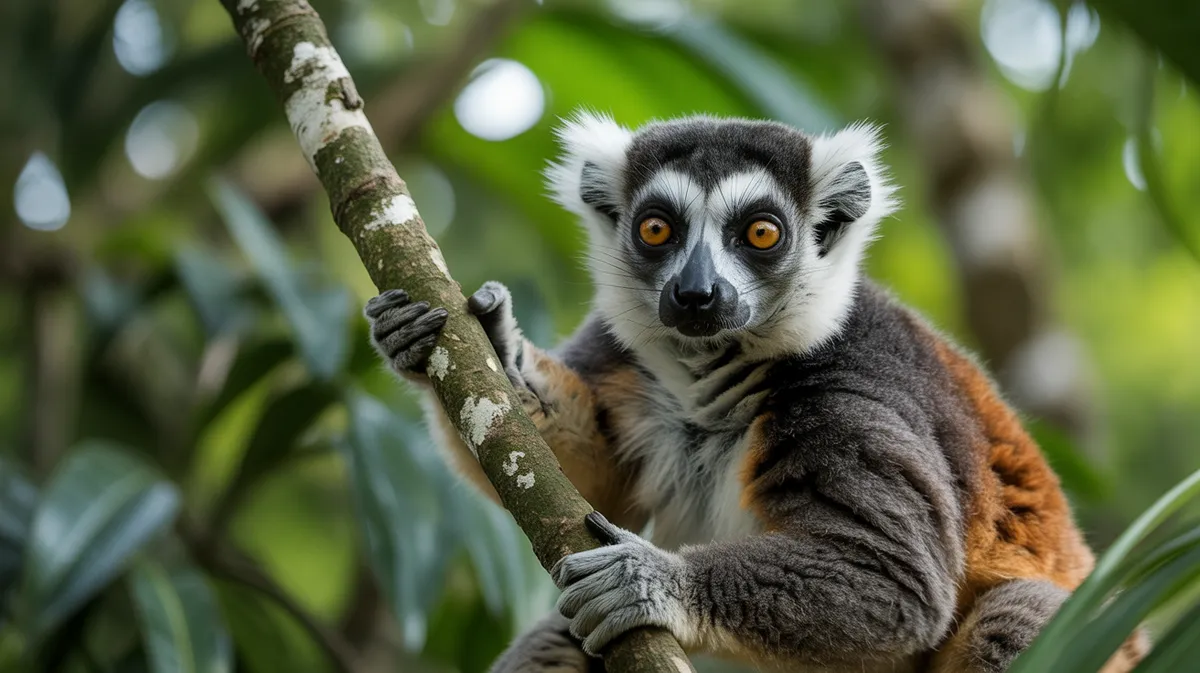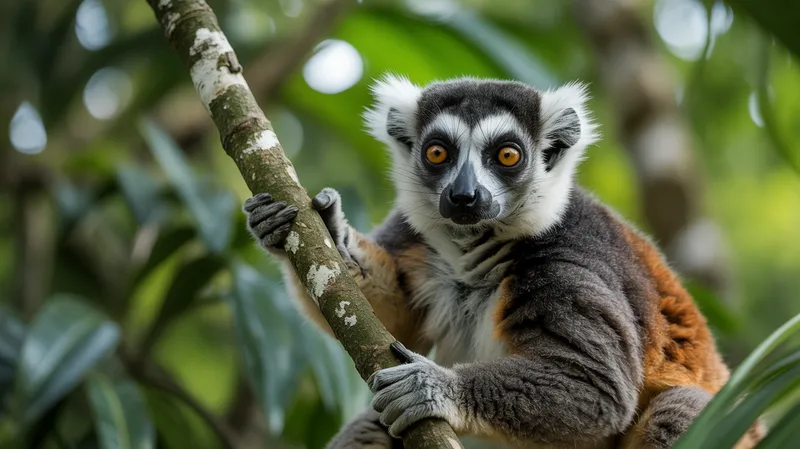
Black Lemur
Eulemur macaco

Meet the Black Lemur
The Black Lemur is a striking primate endemic to the northwestern tip of Madagascar and neighboring islands. Males are entirely black, while females are brown with white ear tufts, making them easily distinguishable by sex. These medium-sized lemurs are highly social and live in groups, primarily inhabiting tropical forests. Black Lemurs are arboreal, spending most of their lives in the tree canopy, and are known for their playful and curious nature. Their populations are threatened by habitat loss and hunting, rendering them vulnerable in the wild.
Classification
Mammal
Habitat
Tropical forest
Diet
Omnivore
Lifespan
18-25 years
Conservation
Vulnerable
Weight
1.5–2.0 kg
📖Fascinating Facts
Arboreal Lifestyle
Black Lemurs spend almost all their time in the trees, rarely descending to the ground except to cross gaps between forest patches.
Role in Ecosystem
They play a vital role in dispersing seeds throughout Madagascar's forests, helping maintain biodiversity.
Sexual Dimorphism
Males are entirely black, while females are brown with orange-brown fur and white tufts on their ears, making the two sexes look very different.
📋Detailed Description
The Black Lemur (Eulemur macaco) is a medium-sized primate, with adults typically weighing between 1.8 and 2.0 kg and measuring 39–45 cm in body length, with a tail nearly as long as the body (41–65 cm). Sexual dimorphism is pronounced: males are entirely black with prominent ear tufts, while females are brown to chestnut with white or cream ear tufts and facial markings. Their dense, woolly fur provides insulation in the humid, often cool canopy of Madagascar’s northwestern forests. Black Lemurs have large, forward-facing eyes adapted for their cathemeral (active both day and night) lifestyle, and a keen sense of smell, important for social communication and foraging. Social groups typically consist of 7–15 individuals, often with a balanced sex ratio and a matriarchal structure, a trait common among lemurs. Communication is complex, involving vocalizations, scent-marking, and visual cues. Their prehensile hands and feet, with opposable thumbs and a grooming claw on the second toe, facilitate agile movement through the forest canopy. Black Lemurs are omnivorous, feeding on fruit, flowers, leaves, nectar, and occasionally invertebrates. Reproduction is seasonal, with a single offspring born after a gestation of about 125 days. The species is highly arboreal, rarely descending to the ground, and plays a crucial ecological role as a seed disperser in its native habitat.
💡 Did you know?
Black Lemurs are one of the few primates known to use millipedes as a form of insect repellent by rubbing them on their fur.
🔬Research & Sources
Wikipedia Summary
The black lemur is a species of lemur from the family Lemuridae. Like all lemurs, it is endemic to Madagascar. Originally, the species was thought to have two subspecies, Eulemur macaco macaco and Eulemur macaco flavifrons, both of which were elevated to species status by Mittermeier et al. in 2008 to Eulemur macaco and Eulemur flavifrons respectively. The most startling difference between the two species is the eye colour; Eulemur flavifrons, the blue-eyed black lemur, has blue eyes, while Eulemur macaco, the black lemur, has brown or orange eyes, and also has ear tufts.
Last Modified: 5/28/2025
🎭Behavior & Social Structure
Black Lemurs exhibit cathemeral activity, meaning they are active at irregular intervals both during the day and night, likely as an adaptation to food availability and predation risk. They are highly social, forming stable groups with both sexes, and maintain group cohesion through frequent grooming and vocal exchanges. Feeding is a group activity, with individuals foraging together for fruits, flowers, leaves, and nectar; they are particularly fond of figs and the nectar of certain palm and traveler’s tree species. They have been observed feeding on millipedes, which they rub on their fur—possibly as a form of insect repellent or self-medication. Scent marking is common, with both sexes using specialized glands to mark territory and communicate reproductive status. Territorial disputes are resolved through vocalizations, scent marking, and occasional physical confrontations. Resting periods are interspersed with feeding and social interactions, and sleeping sites are often reused by the group.
👶Reproduction & Life Cycle
Breeding in Black Lemurs is highly seasonal, typically occurring from April to May, coinciding with the end of the rainy season. Females exhibit a brief estrus period lasting only a few days. After successful mating, gestation lasts about 120–129 days, with births peaking in September and October. Usually, a single infant is born, though twins are rare but possible. Newborns are altricial, clinging to the mother’s belly for the first weeks before transitioning to riding on her back. Maternal care is predominant, but other group members, especially juveniles and subadults, may participate in alloparental care. Weaning occurs at around 5–6 months, and sexual maturity is reached at about 18–24 months. The reproductive rate is low, with females typically producing one offspring per year, contributing to the species’ vulnerability.
🛡️Adaptations & Survival
Black Lemurs display several adaptations to their arboreal, cathemeral lifestyle. Their strong, prehensile limbs and opposable digits allow for precise grasping and agile movement through the forest canopy. The grooming claw on the second toe is used for personal and social grooming, which is vital for hygiene and social bonding. Their large eyes enhance vision in low-light conditions, supporting nocturnal activity. Scent glands located on the wrists and genitalia are used for complex chemical communication. The ability to digest a wide variety of plant materials, including some toxic fruits, allows them to exploit diverse food sources. Their social structure, with female dominance, may help reduce intra-group competition and enhance group stability.
🎨Cultural Significance
In Malagasy culture, lemurs are often regarded with a mixture of reverence and superstition. While some communities consider lemurs to be taboo (fady) to hunt or harm, others may not observe such taboos, leading to localized differences in hunting pressure. Black Lemurs do not have as prominent a role in folklore as some other lemur species, but their striking appearance and behaviors have made them important ambassadors for conservation and ecotourism in Madagascar. They are sometimes featured in local stories as clever or mischievous forest dwellers.
🔬Recent Research & Discoveries
Recent research has focused on the ecological role of Black Lemurs as seed dispersers, highlighting their importance in maintaining forest diversity. Studies have documented their use of millipedes for self-anointing, which may provide chemical defense against parasites. Genetic analyses have clarified the taxonomic distinction between Eulemur macaco and Eulemur flavifrons, supporting their status as separate species. Ongoing research includes population monitoring using camera traps and acoustic surveys, studies of disease transmission between lemurs and humans, and the effects of habitat fragmentation on social structure and genetic diversity. Conservation programs increasingly involve local communities in habitat restoration and sustainable resource management.
🎥Wildlife Videos

For Ring Tailed Lemurs, the Ladies Rule | Wild Love
About Wild Love: Finding love in the animal kingdom is tough business. There's no swiping right here. Instead of an online profile ...
Nat Geo Animals

Wild Madagascar - Fantastic Creatures | Free Documentary Nature
Wild Madagascar - Fantastic Creatures | Free Documentary Nature Watch 'Trouble in Paradise - The Last Lemurs of Madagascar ...
Free Documentary - Nature

Lemurs get high | Spy in the Wild - BBC
Animatronic spy creatures discover that mischief is rife in nature, but there are still rules that govern the animals' lives. Spy in the ...
BBC

The Fascinating World of Madagascar - Where Weird Wildlife Thrives | Full Documentary
Madagascar – the ultimate island. Nowhere else exist so many weird animals at one place. For millions of years, this island lay ...
Free High-Quality Documentaries

The Lemurs Of Madagascar (Wildlife Documentary) | Going Wild
World-renowned naturalist Brian Keating journeys through Madagascar in search of the country's most iconic wildlife. Along the ...
Real Wild

Our Planet | Forests | FULL EPISODE | Netflix
Experience our planet's natural beauty and examine how climate change impacts all living creatures in this ambitious ...
Netflix
🌍Habitat Information
The Black Lemur typically inhabits Tropical forest environments. Black Lemurs have adapted to their environments with specialized features and behaviors.
Primary Habitat:
Tropical forest
More detailed habitat information will be available soon.
🛡️Conservation Status
The Black Lemur is currently classified as Vulnerable. Conservation efforts are crucial for preserving this species for future generations.
Common Threats:
- 🏠Habitat loss and fragmentation
- 🌡️Climate change impacts
- 🎯Hunting and poaching
- 🏭Human-wildlife conflict
⚠️Threats & Conservation Challenges
The Black Lemur faces significant threats from habitat loss due to slash-and-burn agriculture (tavy), logging, and conversion of forest to pasture or plantations. Hunting for bushmeat and capture for the illegal pet trade further reduce populations. Fragmentation of habitat isolates groups, leading to reduced genetic diversity and increased vulnerability to disease. The species is classified as Endangered by the IUCN, with an estimated population decline of over 50% in the past 24 years. Conservation challenges include enforcing protected area boundaries, mitigating human-wildlife conflict, and promoting sustainable livelihoods for local communities. Climate change may exacerbate habitat loss and alter food availability, posing additional risks.
🔬Scientific Classification
Scientific Name
Eulemur macaco
Classification Hierarchy
🔍 About Taxonomic Classification
Taxonomic classification is a hierarchical system used by scientists to classify and organize living organisms based on shared characteristics and evolutionary relationships.
The system moves from broad categories (Kingdom) to increasingly specific ones, with each animal's scientific name typically consisting of its Genus and species.
📝Community Notes
Share your observations and insights about the Black Lemur with our community of wildlife enthusiasts.
Join Our Community
Sign in to share your observations and connect with fellow wildlife enthusiasts.
Sign In to ContributeNo community notes yet
Be the first to share your observations about the Black Lemur!
Explore Black Lemur
Select a tab above to learn more about this amazing animal.
📸Photo Gallery
No photos available for this animal yet.
🌟Discover More Wildlife
Continue your journey of discovery with more fascinating animals from our database
